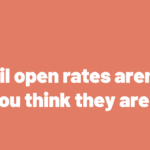Introduction
The macro-economy in the US is tough right now. Inflation is up (driven in large part by insane gas prices) and although consumer spending remains high, many are nervous about how consumers will respond to having an ever-larger chunk of their monthly budget eaten up by fuel costs.
Many digitally native brands (though not all!) saw incredible growth over the last few years. The pandemic accelerated the transition to e-commerce, and many households found themselves with extra cash to spend online due to the government’s economic stimulus package as well as savings that accrued from not being able to pursue social activities or travel during the pandemic.
This means that many brands are facing a very tough year right after some of their best years ever. This whiplash in expectations is causing a lot of fear and uncertainty in marketing teams.
In this post, we’re going to lay out some concrete steps that marketers can take to reduce the impact of an economic downturn on their business, and even take advantage of a once-a-decade opportunity to generate huge returns by outsmarting competitors who may be pulling back or making fear based decisions.
Organizational adjustments
There are a few things you should do to prepare your organization for these times of uncertainty.
Over-communicate
As a marketer, the first thing you should be thinking about is how to communicate the change in expectations to your leadership team and board. If your goal for the year was set based on in-pandemic-times then you might want to revise those goals sooner rather than later. No one likes going to the board with revised estimates, but better to do it now rather than waiting until November.
No one knows how severe a slowdown might be or how long it might last. Communicating early and often is the best way to make sure no one in your business is caught by surprise.
Prepare your mind
Maintain the mentality that you’re going to sell through the slowdown by being smart and finding efficient ways to capture incremental sales. This likely includes becoming more connected with creative, web, and product teams to deliver for your prospects.
Motivate your organization
While marketing in a world of free-money backed by strong economic winds can be fun, challenges can bring out the best in people. You should leverage your company’s existing talent and make sure they’re motivated to rise to the challenge.
The work your marketing team is doing may look very different next year from what you were doing last year. The very best teams are flexible and agile and will respond to those changes with grace. The more you can help motivate your team to rise to the occasion rather than getting depressed about falling ROIs in paid channels, the better off you’ll be.
Optimize what works
When it comes to managing your marketing program, you may no longer be able to rely on throwing more money at the growth problem. You’re going to need to make sure you’re squeezing every last drop of ROI out of your marketing budgets.
First things first, now is a great time to cut inefficient spend. If there are any channels that you know are inefficient (and yes, you probably know which ones those are) you should consider cutting them. If you were hoping to use your growing organic demand to cover up poor performance while you “learn into” broadcast TV as a channel, it might be a good idea to cut that spend back now and save that budget for lean times ahead.
Once you’ve cut those channels, you can use your focus to optimize your best channels. If it’s been a while since you did an overhaul of your facebook account, this might be a great year for that. Working on fixing your google-shopping and catalog integration is another great activity.
Structured creative testing and messaging testing as part of channel optimization can be done inexpensively, while resulting in both higher performing ads and learning about your customers. But, refrain from overmanagement of ad accounts. It’s easy to panic and start pulling lots of levers instead of taking a measured methodical approach that results in better outcomes.
Similarly, if you’ve been thinking about doing deprivation tests in some marketing channels to test for incrementality, now might be a great time for that! Deprivation tests by definition mean cutting spend, and so you get combined benefits. You can both save some budget for a rainy day and get some critical learnings about the true incrementality of your marketing dollars.
Additionally, this year might be a great time to focus on non-paid marketing. Shifting focus from paid media to other marketing activities (email marketing, SEO, etc) can be a great use of time if you need to tighten purse strings. Taking a deep look at your web experience and finding incremental adjustments to improve performance can dramatically increase the value of each marketing dollar.
Be ready to strike
In the aftermath of the 2008 recession, many great marketing-first businesses were built because CPMs went down as competitors went out of business and pulled back on spending. With VCs tightening the purse strings, if CPMs start to come down in key marketing channels this could be the perfect time to double down if you can do so profitably.
If you followed all of the advice in the last section, coming out of a downturn you’ll have a lean-mean and finely-tuned marketing machine ready to rip once capital markets are ready to invest in growth again. By positioning yourself well to take advantage of a vacant playing field and lower CPMs you could turn one year of lower growth into 10 years of market dominance.
About the Authors
Tihomir Liptak is the CEO and Co-founder of the Bodhi digital growth agency. He has extensive experience as a marketer, founder, and entrepreneur growing businesses through good time and bad.
Michael Kaminsky is the co-CEO and co-founder of Recast.



